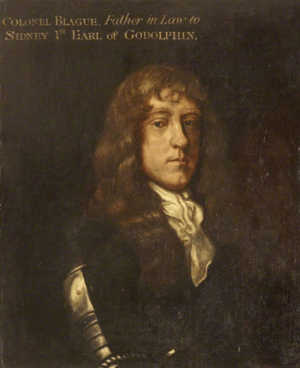Thomas Blagge facts for kids
Quick facts for kids
Thomas Blagge
|
|
|---|---|

Colonel Thomas Blagge
|
|
| Governor of Great Yarmouth and Landguard Fort | |
| In office May 1660 – November 1660 |
|
| Groom of the Chamber to Charles I and Charles II | |
| In office 1635–1660 |
|
| Governor of Wallingford Castle | |
| In office February 1643 – July 1646 |
|
| Personal details | |
| Born | 13 July 1613 (baptised) Little Horringer Hall, Suffolk |
| Died | 4 November 1660 (aged 47) London |
| Resting place | Westminster Abbey |
| Nationality | English |
| Spouse | Mary North (1641–1660; his death) |
| Children | Henrietta Maria; Dorothy; Mary; Margaret |
| Occupation | Soldier and member of the Royal Household |
| Military service | |
| Rank | Colonel |
| Battles/wars | |
Colonel Thomas Blagge (born 1613, died 1660) was a loyal helper to King Charles I and later his son, King Charles II. He had a special job called 'Groom of the Chamber'. This meant he was a close personal servant to the King.
Thomas Blagge was also a brave soldier. He fought for the King's side, known as the Royalists, during the English Civil War. After King Charles I died in 1649, Thomas Blagge went to France. He joined King Charles II, who was living there in exile.
In 1651, he helped King Charles II escape after a big battle. Even though Thomas Blagge was arrested himself, he managed to escape from the Tower of London. He stayed in exile for ten more years. During this time, he fought in the Franco-Spanish War.
When King Charles II returned to England in 1660, Thomas Blagge was rewarded for his loyalty. He was given important jobs, but he sadly died soon after.
Contents
About Thomas Blagge
Thomas Blagge was born in Suffolk, England. He was baptised on July 13, 1613. His family, the Blagges, were part of the wealthy and well-connected gentry (a class of people who owned land). This family background helped him get his job serving the King.
In 1641, Thomas Blagge married Mary North. They had three daughters who grew up: Henrietta Maria, Mary, and Margaret. Margaret later married Sidney Godolphin. He became a very powerful politician in England.
Fighting for the King
When the First English Civil War started in 1642, Thomas Blagge stayed loyal to King Charles I. Many people in his home area of Suffolk supported Parliament instead. But Blagge chose to fight for the King.
He quickly became a trusted leader in the Royalist army. He fought in important battles like Edgehill in 1642. He was also made Governor of Wallingford Castle. This castle was very important because it controlled a key crossing point over the River Thames.
Blagge worked hard to rebuild the castle's defenses. He also led soldiers in other battles, including Cropredy Bridge and Lostwithiel in 1644. Even though the Royalists won some battles, they faced many challenges.
Last Stand and Exile
In 1645, the King's main army was largely defeated at the Battle of Naseby. Thomas Blagge continued to defend Wallingford Castle. His soldiers were starving, but he held out for a long time. He finally surrendered in July 1646, getting good terms for his men because of his strong defense.
After King Charles I was executed in 1649, Thomas Blagge joined King Charles II in France. In 1651, he went with Charles II to Scotland. After the Royalists lost the Battle of Worcester, Blagge helped King Charles II escape capture.

Even though Blagge was arrested himself, he managed to escape from the Tower of London. He then rejoined the King's court. He was again made Groom of the Chamber. His wife, Mary, became a governess (teacher) to Princess Henrietta, the King's sister.
In 1658, Thomas Blagge fought in the Battle of the Dunes. This was part of the Franco-Spanish War. He fought alongside other English exiles who supported the King.
Return to England and Legacy
When King Charles II returned to the throne in May 1660 (an event called the Stuart Restoration), Thomas Blagge was rewarded. He was made Governor of Great Yarmouth and Landguard Fort. These were important positions.
Sadly, Thomas Blagge died just six months later, in November 1660. He was buried in Westminster Abbey. Even though he died young, his loyalty to the King was remembered.
His wife, Mary, worked hard to pay off their debts. She also made sure their daughters had good futures. Two of their daughters, Mary and Margaret, became 'Maids of Honour' to the Duchess of York. This was a special role serving a royal princess. Margaret Blagge was admired by many, including the famous diarist John Evelyn.

